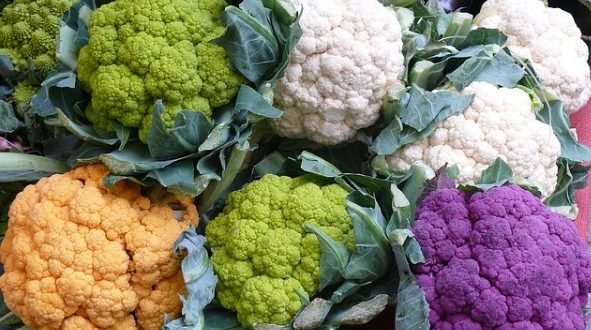We continue our quest to equip you with information on export crops – though you still can grow them for the Zimbabwean market. Cauliflower is grown in at least ninety countries globally. Today I shall be sharing with you what you need to know about cauliflower farming. As usual, I will start with a brief overview of cauliflowers then I will progressively get into more detail.
Brief Overview
The scientific name of cauliflower is Brassica oleracea var. botrytis. That simply means it belongs to the Brassica oleracea family, the variety being botrytis. It almost looks like broccoli so much you would think it is a variety of broccoli, they are different though. It is a type of cabbage of sorts (it belongs to the cabbage family); the overall structure speaks to that. Cauliflower is endowed with rich nutritional content either when it is eaten raw or when it is cooked. It takes cauliflower roughly 3 months to reach maturity which creates room for multiple batches per year. Maturation varies from variety to variety. Some varieties take 2 months to mature whilst some can take as long as roughly 5 months. Globally the biggest producer of cauliflower is China, with India in second place followed by Spain in third place. This effectively makes Asia the hub of cauliflower production in the world.
Importance Of Cauliflower
Cauliflower is rich in carbohydrates and calories – its superior richness is in Vitamins though (C and K in particular). It has great export value and here is something worth noting. There was a study recently conducted that showed that it is the most consumed vegetable in Europe. In light of that Europe can be a strategic export target market. Bear in mind that cauliflower can be exported raw or after beneficiation. Over and above that cauliflower is increasingly becoming a common feature of most dishes. Several studies have shown its potency in warding off cancer and heart diseases – 2 of the most ruthless human health struggles globally. There is so much more we can cover here but the importance of cauliflower cannot be overemphasised.
Production Considerations
Sowing, Transplanting And General Care
It is best to start with seedbeds and then you transplant later. Seeds should be sown roughly a centimetre under the ground. The ideal inter-row spacing is half a metre. Transplanting is usually imminent about a month after sowing. The other tell-tale sign is the number of leaves – if there are about six or so leaves then transplanting can commence. When transplanting inter-row spacing should be 75 centimetres and inter-row spacing should be 30 centimetres.
Farming cauliflowers is considered to be simple and straightforward. In principle, the farming approaches employed in cabbage farming work for cauliflower too. Cauliflower does well in soils with good water retention, good drainage, and good fertility. Several types of soils are suitable for growing cauliflower; optimum pH is between 6 and 6.5. Where possible, soil preparation must include ripping, ploughing, and even discing. If you have to irrigate you must use overhead irrigation. Weed control is very important and must be done especially during the first month after transplanting the cauliflower. It is advised also that boron be applied because cauliflower tends to be susceptible to a lack of boron.
Harvesting And Storage
Typically it takes an average of 3 months for cauliflowers to mature – duration varies as I mentioned earlier. The norm is that maturity is reached faster in summer and takes longer if it is winter. It is advised that the best time for harvesting cauliflower is in the morning. Harvesting is typically done by hand so it is labour-intensive. The most recommended approach is to harvest gradually i.e. as and when the cauliflowers mature.
When cauliflower is ready for harvesting the head (known as the white curd) must be roughly 15 centimetres in diameter. Bear in mind that the height at which cauliflower is mature stands at around 50 centimetres. When harvesting, caution must be exercised to ensure that there is no damage to the heads. They are very delicate and susceptible to damage – any damage no matter how slight can reduce the shelf life of the cauliflower. As soon as they are harvested, the white curds must be kept in plastics to preserve freshness.
The longest shelf life that can be attained for cauliflower is 1 month. To keep cauliflower for that long with its freshness it must be kept at 0 degrees Celsius. If the temperature is around 3 degrees Celsius, they can last for half a month. The rule of thumb is that the higher the storage temperature gets, the shorter the shelf life.
Important Factors To Consider
The optimum soil for the cultivation of cauliflower is that which is rich in nitrogen. Optimum growth temperature is 16 degrees on average – a range of 16 to 20 degrees Celsius is okay. Extremities are detrimental i.e. temperatures should not be too low or too high. Cauliflower is vulnerable to both diseases and pests. Some of the common diseases are club root and black rot whereas aphids and worms are some of the common pests.
It is important to note that cauliflower is generally very hard to grow during hot seasons (summer in particular). In conditions like that, they will reach maturity sooner than they should. Thus their curds or heads will be small and exposed (due to poorly developed leaves). So they must be grown under temperatures I pointed out some moments ago.
The Best Cauliflower Varieties To Choose
There are so many cauliflower varieties to choose from. Choices do depend on characteristics of varieties, availability, and weather patterns, amongst others. For instance, cauliflower varieties have different colours – they are white, green, yellow, and purple. Examples of popularly cultivated varieties are Candid, Charm, Incline, Apex, and Panther.
The best yields attainable per hectare would be around 40 tonnes (or 25 000 heads).








